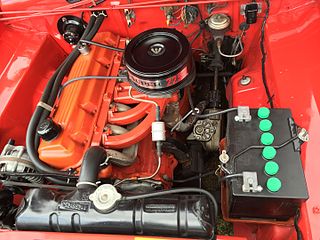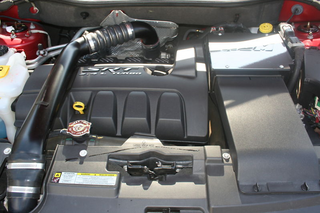
The Chrysler B and RB engines are a series of big-block V8 gasoline engines introduced in 1958 to replace the Chrysler FirePower engines. The B and RB engines are often referred to as "wedge" engines because they use wedge-shaped combustion chambers; this differentiates them from Chrysler's 426 Hemi big block engines that are typically referred to as "Hemi" or "426 Hemi" due to their hemispherical shaped combustion chambers.

The LA engines are a family of pushrod OHV small block 90° V-configured gasoline engines built by Chrysler Corporation. It was factory-installed in passenger vehicles, trucks and vans, commercial vehicles, marine and industrial applications from 1964 through 1991 (318) & 1992 (360). The combustion chambers are wedge-shaped, rather than the polyspherical combustion chambers in the predecessor A engine or the hemispherical combustion chambers in the Chrysler Hemi engine. LA engines have the same 4.46 in (113 mm) bore spacing as the A engines. LA engines were made at Chrysler's Mound Road Engine plant in Detroit, Michigan, as well as plants in Canada and Mexico. The "LA" stands for "Light A", as the older "A" engine it was closely based on was nearly 50 pounds heavier. Willem Weertman, who later became Chief Engineer – Engine Design and Development, was in charge of the conversion. The basic design of the LA engine would go unchanged through the development of the "Magnum" upgrade (1992-1993) and into the 2000s with changes to enhance power and efficiency.

The Slant-Six is the popular name for a Chrysler inline-6 internal combustion engine with a reverse-flow cylinder head and cylinder bank inclined at a 30-degree angle from vertical. Introduced in 1959, it was known within Chrysler as the G-engine. It was a clean-sheet design that began production in 1959 at 170 cubic inches (2.8 L) and ended in 2000 at 225 cubic inches (3.7 L).

The Chrysler 1.8, 2.0, and 2.4 are inline-4 engines designed originally for the Dodge and Plymouth Neon compact car. These engines were loosely based on their predecessors, the Chrysler 2.2 & 2.5 engine, sharing the same 87.5 mm (3.44 in) bore. The DOHC head was developed by Chrysler with input from the Chrysler-Lamborghini team that developed the Chrysler/Lamborghini Formula 1 V12 engine in the early 1990s.

The Chrysler flathead engine is a flathead automotive engine manufactured by the Chrysler Corporation from 1924 through the early 1960s. The flathead engine came in four-,six, and eight-cylinder configurations and varying displacement, with both a cast iron and cast aluminum cylinder head. It was installed in Chrysler, DeSoto, Dodge and Plymouth branded vehicles.

This engine was Chrysler's first 60° V6 engine designed and built in-house for front wheel drive vehicles, and their first V6 not based on a V8. It was designed as a larger, more powerful option to the Mitsubishi 3.0 V6 in the minivans and debuted in 1989 for the 1990 model year.

The Chrysler Hemi-6 engine is a family of inline six-cylinder petrol engines produced by Chrysler Australia in three piston displacements and multiple configurations. Hemi-6 engines were installed in Australian-market Chrysler Valiants from 1970 through 1981. It was also installed in the Valiants closely related variants, the Chrysler VIP, the Chrysler by Chrysler & the Valiant Charger.

The Pontiac V8 engine is a family of overhead valve 90° V8 engines manufactured by the Pontiac Division of General Motors Corporation between 1955 and 1981. The engine featured a cast iron block and head and 2 valves per cylinder. Engine block and cylinder heads were cast at Saginaw Metal Casting Operations then assembled at Tonawanda Engine before delivery to Pontiac Assembly for installation.

The Plymouth Fury is a model of automobile which was produced by Plymouth from 1955 to 1989. It was introduced for the 1956 model year as a sub-series of the Plymouth Belvedere, becoming a separate series one level above the contemporary Belvedere for 1959. The Fury was a full-size car from 1959 to 1961, then a mid-size car from 1962 to 1964, again a full-size car from 1965 to 1974, and again a mid-size car from 1975 to 1978. From 1975 to 1977 the Fury was sold alongside the full-size Plymouth Gran Fury. In 1978, the B-body Fury was the largest Plymouth, and by 1979, there was no large Plymouth. This was rectified in 1980 with the R-body Gran Fury, followed by the M-body Fury in 1982. Production of the last V8, RWD Plymouth Fury ended at Kenosha, WI, on December 23, 1988. Unlike its sibling brand, Dodge, Plymouth would not live to see the resurgence of the large, V8/RWD sedan. The nameplate "fury" is from Latin for "rage, extreme anger, strength or violence in action"

Plymouth Belvedere is a series of American automobile models made by Plymouth from 1954 to 1970. The Belvedere name was first used for a new hardtop body style in the Plymouth Cranbrook line for the 1951 model year. In 1954 the Belvedere replaced the Cranbrook as the top trim and became a full model line with sedans, station wagons and convertible body styles. The Belvedere continued as Plymouth's full-sized car until 1965, when it became an intermediate, and was replaced after the 1970 model year by the Satellite, a name originally used for the top-trim level Belvederes. The nameplate "belvedere" is Italian for "beautiful sight" or “fair view”. Chrysler also had the Belvidere Assembly Plant in Belvidere, Illinois which began production in 1965.

The AMC V8 may refer to either of two distinct OHV V8 engine designs that were developed and manufactured by American Motors Corporation (AMC). The engines were used in cars and trucks by AMC, Kaiser, and International Harvester as well as in marine and stationary applications.

The Plymouth Savoy is an automobile model produced from the 1954 through 1964 model years by Plymouth.

The Dodge Mayfair was an automobile built by Chrysler Corporation of Canada Ltd. This vehicle was produced solely for the Canadian market from 1953 to 1959. Its American equivalent was the Plymouth Belvedere. It was based on the Plymouth.
The Lincoln Y-block V8 engine was Ford's earliest OHV V8 engine, introduced by Lincoln in the 1952 model year. Like the later and better-known but even more short-lived Ford Y-block engine, its block's deep skirts gave the block the appearance of the letter Y from the front.

The Chrysler Hemi engines, known by the trademark Hemi, are a series of American I6 and V8 gasoline engines built by Chrysler with hemispherical combustion chambers. Three different types of Hemi engines have been built by Chrysler for automobiles: the first from 1951 to 1958, the second from 1964 to 1971, and the third beginning in 2003. Although Chrysler is most identified with the use of "Hemi" as a marketing term, many other auto manufacturers have incorporated similar designs. The engine block and cylinder heads were cast and manufactured at Indianapolis Foundry.

The Simca Poissy engine, commonly known as the Simca 1100 engine, was a four-cylinder Overhead valve engine developed by Simca for use in its superminis and economy cars, designed by the engineer Georges Martin. In spite of its common name, the engine actually predates the Simca 1100 model, and debuted in 1961 in the Simca 1000 Coupé. It was developed and produced by Simca in the late 1960s at the manufacturer's factory in Poissy, hence its name.

The single overhead cam V6 engine introduced in 1993 was a major advancement for Chrysler. It was derived from Chrysler's first homegrown front-wheel drive V6, the Chrysler 3.3 engine. The SOHC V6 has been replaced by the Chrysler Pentastar engine.
The Polyspheric or Poly engines were V8 engines produced by Chrysler from 1955 to 1958 as lower-cost alternatives to the Hemi engines. These engines were based on the Hemi engines, using the same blocks and crankshaft parts, but completely different cylinder heads, pushrods, exhaust manifolds and pistons.

The World Gasoline Engine is a family of straight-4 piston engines, based on the Global Engine Alliance design.

The Dodge Series D8 appeared in October 1937 for the 1938 model year, replacing the previous year's Series D5. Production of the 1938 Dodges ran from September 1937 until July 1938, which was the typical pattern for Dodge in this period. As before, there was also a "Junior" line of Plymouths using Dodge badges and trim for the Canadian and global export markets. The main version is sometimes referred to as the "Senior" Dodge to distunguish the two.


















